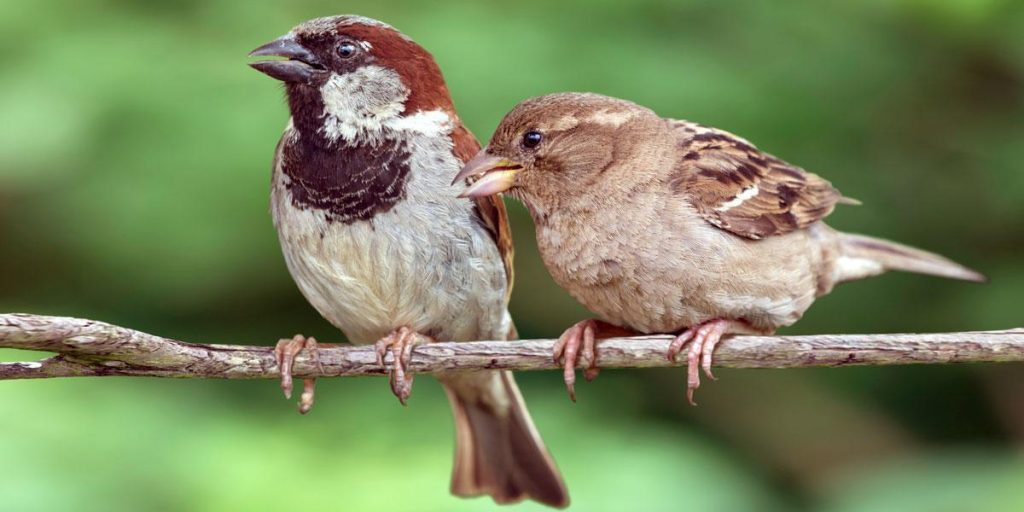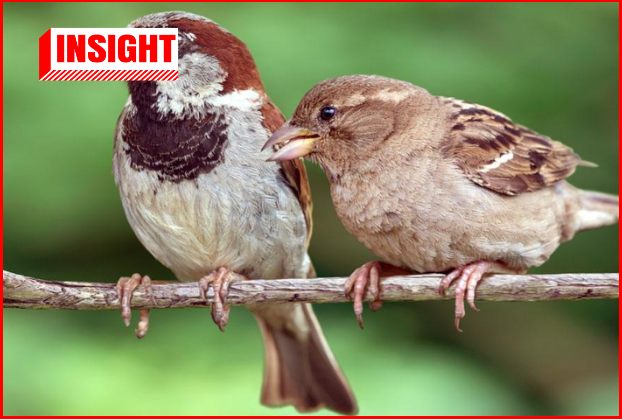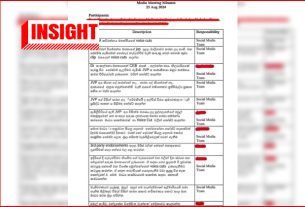Subscribe to our WhatsApp Channel
Sparrows are small passerine birds found worldwide. They are known for their chirping songs and friendly behaviour. They are often seen in urban and rural areas, nesting in trees, shrubs, and even man-made structures. While some species are declining due to habitat loss and other factors, sparrows are generally adaptable and resilient birds.
However, a piece of recent news indicated that sparrows from 18 districts of Sri Lanka are extinct due to the impact of mosquito coils and other repellants.

We decided to do check the background of these claims.
Sparrows in Sri Lanka –
Sri Lanka has several species of sparrows. The origin of this bird is from the family Passeridae. However, in Sri Lanka, the most common sparrow species is house sparrows (ගේ කුරුල්ලා). The scientific name of the house sparrow is Passer domesticus.

They are common in Sri Lanka, mainly in urban and suburban areas. These small, chunky birds are known for their brown and grey plumage, with males spotting a black bib-like patch on their throat area during the breeding season. They are often found nesting in nooks and crannies of buildings, trees, and bushes. Despite being introduced to Sri Lanka, house sparrows have adapted well to the island’s environment and can be seen foraging for food in gardens, parks, and even along the roadside.
Adult house sparrows mainly feed on weeds and grains. However, this behaviour can be adaptable to the environment in which it is lived.
Population Drop of House Sparrows in Sri Lanka –
House sparrow population drops are commonly discussed worldwide. This situation is not one that Sri Lanka has faced alone. Several factors threaten the sparrow population of India, Europe, and many other countries.

Research conducted on house sparrow populations in India has shown a few reasons for the population drop, such as other predators, human activities, urbanisation, pesticides, depleting food sources, and pollution.

Here is another study which sheds light on a similar number of several factors which are contributing to the decline of house sparrows in Punjab.
However, in the IUCN Red List, sparrows are considered the ‘most minor concern’ birds because of their conservation status. However, compared to the earlier 1990s, we can see an apparent drop in the number of house sparrows in Sri Lanka. In some areas, house sparrows cannot even be found easily.
Here is an article we have previously written on the effect of climate change on the sparrow population drop in Sri Lanka.
Why are the Mosquito Repellents Suspicious of Threatening House Sparrows? –
We contacted Dr. Jagath Gunawardana, a lawyer, environmentalist, and educator based in Sri Lanka, to learn more about this. He indicated that the main threat that the humble house sparrows have faced is primarily human activities and the changes in human behaviour.
He mentioned that he had seen house sparrows very commonly everywhere in the 1970s, and now, it is not easy to find them in their late habitats. The population drop of the house sparrow in Sri Lanka was visible. In the 1970s, malathion was sprayed in different areas, and a drop in the number of house sparrows was initiated then.
Dr Jagath Gunawardana said it is possible that mosquito repellents used by people negatively impact house sparrows. He observed a rapid drop in the population of house sparrows in suburban areas. In Particular, there are fewer house sparrows near human houses.
However, it is possible to find more house sparrows in urban areas, especially in bazaar areas, than human households. Bazaars and stores are steaming with people, primarily during the day. At night, there is very little crowd in these places. The mosquitos are common in the evening and night times. So, mosquito repellents such as mosquito coils are common in the daytime, in stores, and bazaars. As a result, they can be impacted by the chemicals of these mosquito repellents. Dr Jagath Gunawardana said that according to these observations, mosquito repellents could be the main reason for reducing the house sparrow population in Sri Lanka.
Dr. Gunawardana further explained the possible threat of mosquito repellents on sparrows. Mosquito repellents include chemicals. An artificial pyrethroid is one of them. Pyrethroid acts as an insecticide or plant-derived substance such as citronella. Synthetic pyrethroids are used in mosquito coils. These artificial pyrethroids have been shown to disrupt calcium metabolism in animals. These chemicals can interfere with the functioning of voltage-gated calcium channels, which play a crucial role in regulating the flow of calcium ions into cells. Calcium is essential in birds for their health and reproductive success.
- Bone health – Calcium is a critical component of bone structure. Disruption in calcium metabolism can weaken bones, making birds more prone to fractures and skeletal deformities.
- Muscle function – Calcium is crucial for muscle contraction. Changes in calcium levels can result in muscle weaknesses, spasms and impaired movement, affecting a bird’s ability to forage, fly and evade predators.
- Nerve function – Calcium ions are involved in nerve transmission. Altered calcium metabolism can lead to neurological problems, including impaired coordination, balance and reflexes.
- Reproduction – Calcium is vital for the formation of eggshells in female birds. Disruption in calcium metabolism can lead to thin or brittle eggshells, increasing the risk of egg breakage and reproductive failure. In extreme cases, it can even lead to egg binding, where eggs become stuck inside the female’s reproductive tract, posing severe health risks.
Here is an article on calcium metabolism in birds.
House sparrows live very close to households and are quickly exposed to mosquito repellents and pyrethroids. Thus, compared to other bird species, house sparrows face greater danger due to the adverse effects of mosquito repellents.
Habitat Loss –
Dr Jagath Gunawardena showed more house sparrows in urban areas than in human households. However, urban shops and bazaars are changing rapidly, and some are also challenging sparrows. Old stores in urban areas were built into typical, old architecture. This includes many small lintels to get better ventilation into the building. But many such structures are now being demolished and replaced by modern buildings. The matter is that these modern buildings are designed for air conditioning and do not keep any space or lintel.
House sparrows build their nests in such spaces or lintel. Blocking or destroying these spaces is blocking access to their nesting habitat.
Why are House Sparrows Important? –
House sparrows play several vital roles in their ecosystem.

- Seed dispersal—Like many other bird species, house sparrows help spread seeds through their droppings. This contributes to the regeneration of plant populations and helps maintain biodiversity.
- Insect control – House sparrows are voracious insect eaters, consuming various pests such as flies, mosquitoes and agricultural pests. Their appetite for insects helps keep the insect population in check, reducing the need for chemical pesticides in some areas.
- Indicator species – The presence or absence of house sparrows in an area can indicate the environment’s health. Changes in their population densities or behaviours may signal shifts in habitat quality, pollution level or the availability of food resources.
- Cultural and economic value
As we discussed above, Sri Lankan environmentalist Dr Jagath Gunawardena suggests mosquito coils and repellents might be the main reason for harming sparrow populations. While his reasoning has a scientific basis, extensive research points to a wider range of causes for the sparrow decline, including global climate change. Habitat loss due to urbanisation, pesticide use, and competition for food and nesting sites from invasive species are all significant factors. Therefore, it’s more likely that a combination of various threats, including chemicals from pesticides, is impacting the sparrow numbers in Sri Lanka.
Follow us and stay up to date with our latest fact checks.
Facebook | Twitter | Instagram | Google News | TikTok

Title:How Are Mosquito Coils Impacting House Sparrow Population in Sri Lanka?
Fact Check By: Fact Crescendo TeamResult: Insight






